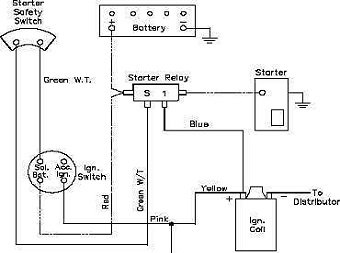
Circuit malfunctions can cause many automotive devices to become inoperative. However, there are only three electrical conditions that cause an inoperative circuit.
These three conditions are number one, an opened circuit. Number two would be a short and number three is a grounded condition.
Below I will explain each electrical problem in more detail. The reason you should read the following page is, because it will aid you in diagnosis when an electrical component is not working. If you’re using a wiring diagram or taking voltage checks on the automobile, understanding the three primary reasons for failure is important to isolating the root cause.
Open Circuit Condition
Whenever there is a complete open or interruption in the normal current path, such as a break in the wiring from the source of power to the electrical unit or even within the unit itself, current will not flow as per design intent.
In an automotive electric circuit, current normally travels through the wires or cables, through switches, and the device itself such as a starter motor or wiper motor. A break anywhere along this route results in an open circuit and the complete loss of power.
Some electrical manuals will describe this open as infinite resistance in the circuit. An open condition can cause your automotive meter to read out of limits or OL. However, the symptoms will appear somewhat different than the typical high resistance circuit.
The difference is there is no heat created by this type of infinite resistance, because there is no current flow or circuit load. An example of the root cause of an open circuit or high resistance circuit can occur as a result of a broken wire within the wiring harness.
Keep in mind that loose or corroded connections at the terminals of the electrical device, broken leads and damaged circuit boards inside the device itself are often more common with an open circuit condition.
Note that even poor grounded connections between the electrical load and chassis ground could be considered an open condition. Open circuits depending on there type and location can easily create other related and or mysterious circuit malfunctions.
Electrical Short Circuit Conditions
The term short circuit is used to describe another type of problem or condition which can develop into an electrical circuits malfunction. A short refers to an electrical path that’s completed in the wrong way.
A common example would be two bare wires touching each other, so the current bypasses part of the normal circuit flow. Bypassing part of the normal circuit simply means the current has found a path of least resistance and a higher current flow is the result.
This results in blown fuses, wiring or component overheating, burned parts of a wires installation and damaged electronic components. The reason for these severe symptoms is because a shorted electrical circuit allows more current to flow through the conductor, circuit board or wire than it was designed to handle.
Too much current known as an overloaded circuit causes the conductor to heat up. If the overload is severe or lasts long enough, it can melt parts in the system.
If the melted wire resides insides of a harness, this destruction can take out healthy neighboring wires, causing a hard to trace chain reaction. The unique smell of burnt wiring insulation is always a sure sign of circuit malfunctions. Note that the wire can melt to the point where it disintegrates and causes an open circuit that was covered in-depth above.
What is a Grounded Circuit
A grounded circuit is similar to a short circuit. In that the current bypasses part of the normal circuit path. But in this instance, by going directly to a ground source. An exposed wire directly touching ground may cause this.
Also part of the internal circuitry within an electrical component can come in contact with a ground source by touching the housing of the unit itself. You have to remember that in many situations electrical components will be case grounded. This simply means that the attaching bolts provide the system ground for the given electrical circuit.
Deposits of oil, dirt and moisture around electrical connections or terminals can provide an excellent path so that the current flows to ground.
This may also cause a grounded circuit condition. Remember that current flows through the path of least resistance in attempting to complete its circle back to ground. These three types of circuit malfunctions are things that you will find as the root cause of your car electrical problems.
You should keep this in the back of your mind when you are using a wiring diagram to diagnose suspected electrically related automobile complaints. Give this circuit malfunctions page a bookmark or share. Then watch some of my exclusive car repair videos from the links below.
Learning more about the basic theory of electricity is valuable knowledge to have under your belt. But more importantly, when you understand how it works diagnosis and auto repair becomes much easier. Learn more from me about automotive electrical.
I put together a repair video that shows you some tricks and techniques I use for quick diagnosis. See the method I was taught for the proper use of automobile wiring diagrams.People seem to like the auto repair how to videos I put together. Here is one that shows you how to use online car repair manuals.The homepage is available from this next link. You can get a brief summary of what else is covered on this website. The next link takes you from circuit malfunctions to auto repair advice.

